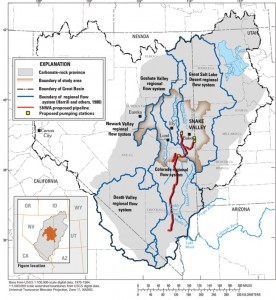
Depending on its success in the courts the water war between Las Vegas and rural Nevada might get a little more real as some opponents to the water exchange legal tactics for sabotage, vandalism and physical intimidation.
“The pipeline project is symbolic of the unlimited growth that the city of Las Vegas is striving for. There are real physical limits on these natural systems that have already been exceeded through dams and all sorts of expensive and destructive projects. This is just the latest in a long series of water grabs in the Southwest, and each one has been an ecological and cultural disaster,” said Max Wilbert of the Great Basin chapter of the Deep Green Resistance in an e-mail Wednesday.
“The SNWA pipeline and other large infrastructure projects around the world are being pushed through by the rich and the powerful with no consideration for the poor, let alone for the health of the land,” he added. “This project is an epic mistake, and you shouldn’t be surprised if you see resistance to this project – and many others like it – turning towards militant, by-any-means-necessary tactics. When people have there back up against the wall, and any option for peaceful resolution has been foreclosed, they will do what it takes.”

Wilbert is a self described activist working on issues of environmental and social justice who lives in Salt Lake City.
His and his group have given more than just rhetoric against the SNWA water grab it has also donated money, time and effort.
Deep Green proudly announced it had donated to the first annual Shoshone Walk Run protest of the water grab scheduled to begin May 3 in Wells and end on Mother’s Day in Caliente.
The movement’s philosophy was outlined in a book titled Deep Green Resistance: Strategy to Save the Planet by Aric McBay, Lierre Keith, and Derrick Jensen was released in May 2011. The book is divided into four sections and is intended to provide a framework from which readers can build upon in order to begin fighting for environmental change.
Proponents of Deep Green Resistance encourage strategies for social action that run the gamut from violent to nonviolent. DGR’s support for violent action all largely center around hard-hitting infrastructural vandalism, such as explosive dam removal, rather than any kind of personal violence.
Jensen predicts, regarding the movement, that acts of personal violence in the future will be almost completely offensive by those countering the resistance movement (i.e. those currently in power) and self-defensive by those enacting the resistance movement. Regarding the topic of violent action, Jensen has responded that “No matter what you do, your hands will be blood red… because the global economy is [already] murdering humans and non-humans the planet over….” And “As this culture continues to collapse, those who are doing the exploiting will continue…. Don’t blame those who want to stop that exploitation. Instead, help to stop the exploitation that is killing people in the first place.” Jensen has also clarified such ideas on Democracy Now!: “I get accused of being the ‘violence guy’… But I don’t ever think that’s really fair, because I really consider myself the ‘everything guy’, that I want to put everything on the table and talk about all forms of resistance…. We can certainly parse out cases where we think it’s appropriate to have militant response or non-militant response.”
In the case of the water grab a militant response might soon be the only card left to play for its opponents.
Ever since the water grab began in 1990 opponents have waged legal battles on the local, state, and federal levels. While the lawsuits, appeals and other legal actions have delayed the pipeline many concede that the political and economic power wielded by Las Vegas will eventually lead to the approval of the water grab and the pipeline.
In the last year, the estimated $15 billion pipeline had won approval from the Nevada State water engineer; the project environmental impact study was okayed ; and the project had the endorsement of the Nevada political establishment.
The last best chance for opponents to prevail in the legal arena will be next month in Ely where appeals will be heard against the Nevada water engineer’s approval of the pipeline from four northern Nevada water sheds in White Pine County District Court.
SNWA opponents scored a political victory of a sorts when Utah governor Gary Herbert In an 11th hour decision reversed himself and said he would not sign a controversial water-sharing agreement with Nevada.
“At the end of the day, when it comes down to those people who have the most to lose — it’s their water, their lifestyle, their livelihood — I can’t in good conscience sign the agreement,” he said. “It’s that simple.”
 Embarrassing revelation that the SNWA was badly mismanaging the ranches it purchased hurt the authority’s standing in Las Vegas but the very inertia of the project seems to be inexorably leading to its approval and construction.
Embarrassing revelation that the SNWA was badly mismanaging the ranches it purchased hurt the authority’s standing in Las Vegas but the very inertia of the project seems to be inexorably leading to its approval and construction.
That is if things stay peaceful.
Even before the emergence of the Deep Green Resistance whispers about sabotaging the pipeline if it ever came to pass could be heard in various gatherings in rural Nevada.
And it would not be the first time that a major water project generated something more explosive that a legal brief.

In the early 20th century, the Owens valley became the scene of a struggle between local residents and the city of Los Angeles over water rights. William Mulholland, superintendent of the Los Angeles Department of Water and Power (LADWP) planned the 223 miles (359 km) Los Angeles Aqueduct, completed in 1913, which diverted water from the Owens River. Much of the water rights were acquired through subterfuge, with purchases splitting water cooperatives and pitting neighbors against each other. By the 1920s, the aggressive pursuits of the water rights and the diversion of the Owens River precipitated the outbreak of violence known as the California Water Wars. Farmers in Owens Valley attacked infrastructure, dynamiting the aqueduct numerous times and opening sluice gates to divert the flow of water.
The SNWA pipeline system is more than five times the size of Owens Valley system and with modern technology possibly thousands of times more vulnerable to sabotage.
From almost every aspect the proposed pipeline is a perfect candidate to suffer some kind of vandalism on almost every level.
While officially the Great Basin Water Network, the chief water grab opponent has distanced itself from threats of violence the mood of some of its members might not be so congenial.
“We are definitely opposed to any illegal or violent actions regarding the pipeline,” said board member Abby Johnson Tuesday.
On the other who would guarantee that a rural rancher running a back hoe in the wilderness might just accidentally break a section of the pipeline that is turning land that his family has farmed for seven generations into a dust bowl?
Who could also promise that hikers or hunters would survey stakes into fire wood or even move them around?
For environmental activists sabotaging a pipeline that would drain ‘pristine’ wilderness to fill Las Vegas swimming pools, the symbolism is perfect.
For the environmental movement there simply is no city the best embodies all that is wrong with Western civilization than Las Vegas. Built where no city should be built, fueled by greed and lust, Nevada’s capitol of sin is an anathema to radical environmentalists who have characterized it as a ever growing eyesore that produces extreme wealth for a very few and poverty for the masses.
Attacking the pipeline would also generate national news and garner at least some sympathy from some sectors of the public even if unsuccessful.
As proved by the election and reelection of Barrack Obama knocking Las Vegas is not an unpopular stance to take. The president even carried Nevada twice.
While the SNWA has probably taken occasional vandalism into account both in the building and the maintenance of the pipeline a sustained organized effort by a group of zealots almost certainly did not enter the equation.
 Local law enforcement including county sheriff’s departments, the Nevada Highway Patrol, the Nevada Department of Wildlife as well as federal agents from the BLM or even the FBI would be hard pressed to respond to sabotage let alone patrol more than a 1,000 miles of pipeline running through some of the most remote areas in the United States.
Local law enforcement including county sheriff’s departments, the Nevada Highway Patrol, the Nevada Department of Wildlife as well as federal agents from the BLM or even the FBI would be hard pressed to respond to sabotage let alone patrol more than a 1,000 miles of pipeline running through some of the most remote areas in the United States.
The cost of employing an army of private security guards could be daunting and while modern surveillance systems such as the use of cameras and sensors are available they don’t come cheap and can be easily disabled or damaged by weather, livestock or humans. Drone aircraft cost at least $1,000 to operate for an hour and there are methods, some very cheap ones, to either blind a drone or bring it down. That cost does not include the price of the unmanned aircraft itself which can run $20,000 each.
The pipeline is also a sitting duck and because of its very nature it cannot be hidden. Accurate maps of exactly where it is and how deep it is buried will not only have to be filed but be part of the public record. And unlike the court cases sabotage has no time limit. If an initial attack is thwarted there is no guarantee that another a month, a year, even ten years in the future will not be successful. Despite winning on every legal front, the threat of sabotage could mean that Las Vegas will run dry.

